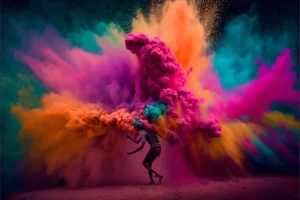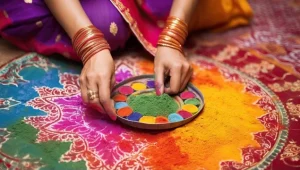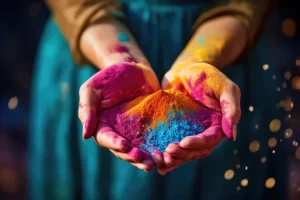 Holi is celebrated on the full moon day of Phalguna (February-March). It coincides with the arrival of spring and the tail of winter. Spring is the season of change close to the Rabi harvest. This is when the old foliage begins to shred (abscission) and the new leaves arrive (leaf out). It is during Holi that nature reviews Mother Earth.
Holi is celebrated on the full moon day of Phalguna (February-March). It coincides with the arrival of spring and the tail of winter. Spring is the season of change close to the Rabi harvest. This is when the old foliage begins to shred (abscission) and the new leaves arrive (leaf out). It is during Holi that nature reviews Mother Earth.
The Europeans were particularly fascinated by the festival of colours. They described it as ‘“the carnival of the Hindus,” or the “Hindu spring festival” in the honour of Krishna, the amorous cowherd.’ Though Holi reminds you of the colourful rainbow, it is certainly not an illusion but a cultural reality of spirit and shades that bucks India up in the backdrop of  Maja-Masti, reminding you of the famous Amitabh Bachchan song, ‘Khai Ke Paan Banaras Wala’ from the film Don. Holi has given countless movies and dance sequences to Bollywood the entertainment centre of India, like, ‘Holi Aayi Re’ from the film Mashaal, the famous Hema Malini (Holi) dance sequence from the film ‘Sholay’ and the all-time great iconic Holi song, ‘Rang Barse Bhige Chunar Wali’ picturised on Rekha, Jaya Bachhan Amitabh Bachchan and Sanjeev Kumar, in the film Silsila.
Maja-Masti, reminding you of the famous Amitabh Bachchan song, ‘Khai Ke Paan Banaras Wala’ from the film Don. Holi has given countless movies and dance sequences to Bollywood the entertainment centre of India, like, ‘Holi Aayi Re’ from the film Mashaal, the famous Hema Malini (Holi) dance sequence from the film ‘Sholay’ and the all-time great iconic Holi song, ‘Rang Barse Bhige Chunar Wali’ picturised on Rekha, Jaya Bachhan Amitabh Bachchan and Sanjeev Kumar, in the film Silsila.
 Holi celebrates the empyrean love of Radha and Krishna. It highlights the ascendancy of good over evil and marks the victory of Lord Vishnu as Narasimha over
Holi celebrates the empyrean love of Radha and Krishna. It highlights the ascendancy of good over evil and marks the victory of Lord Vishnu as Narasimha over  had the boon of not getting incinerated by fire but on that fateful day, the reverse happened. She got burnt and Prahalada came out unscathed. Soon, Lord Vishnu appeared as an avatar to restore Dharma and took the form of Narasimha – half human and half lion (which is neither human nor an animal), at dusk (when it was neither day nor night). He took Hiranyakashipu to the doorstep (which was neither indoor or outdoor), placed him on his lap (which was neither land, water nor air), and then eviscerated and killed him with his lion claws (which were neither a handheld weapon nor a projectile).
had the boon of not getting incinerated by fire but on that fateful day, the reverse happened. She got burnt and Prahalada came out unscathed. Soon, Lord Vishnu appeared as an avatar to restore Dharma and took the form of Narasimha – half human and half lion (which is neither human nor an animal), at dusk (when it was neither day nor night). He took Hiranyakashipu to the doorstep (which was neither indoor or outdoor), placed him on his lap (which was neither land, water nor air), and then eviscerated and killed him with his lion claws (which were neither a handheld weapon nor a projectile).
 Holi is played with dry (Abir & Gulal) and wet colours with a traditional pichkari (water gun) that reminds you of the Bollywood song ‘Balam Pichkari’ from the film ‘Yeh Jawaani Hai Deewani.’ The revellers even chorus ‘bura na mano Holi hai’. People form tolis (small groups) and move from one house to the other, to their friends and relatives wishing them a ‘Happy-Holi’ and singing songs and bhajans. They also hug (Gale Milna) each other on the occasion. The dry and wet playing colours depend on the weather. On the foregoing night of Holi, a bonfire is lit on the roads which is symbolic of the Holika-Dahan (the incineration of Holika) the victory of good over evil—Prahalada over Hiranyakashipu. Celebrants get smoldering twigs of that fire to their homes as a symbol of the victory of right over wrong and to rid their homes of any evil omens. People eat mithai, gujia, shakkar paare, dahi-vada, bhang and drink thandai. They forgive and forget their past differences and come together once again. Nature has created umpteen occasions for human beings to come together and Holi is one of them.
Holi is played with dry (Abir & Gulal) and wet colours with a traditional pichkari (water gun) that reminds you of the Bollywood song ‘Balam Pichkari’ from the film ‘Yeh Jawaani Hai Deewani.’ The revellers even chorus ‘bura na mano Holi hai’. People form tolis (small groups) and move from one house to the other, to their friends and relatives wishing them a ‘Happy-Holi’ and singing songs and bhajans. They also hug (Gale Milna) each other on the occasion. The dry and wet playing colours depend on the weather. On the foregoing night of Holi, a bonfire is lit on the roads which is symbolic of the Holika-Dahan (the incineration of Holika) the victory of good over evil—Prahalada over Hiranyakashipu. Celebrants get smoldering twigs of that fire to their homes as a symbol of the victory of right over wrong and to rid their homes of any evil omens. People eat mithai, gujia, shakkar paare, dahi-vada, bhang and drink thandai. They forgive and forget their past differences and come together once again. Nature has created umpteen occasions for human beings to come together and Holi is one of them.
For foreigners, the bright colours of Holi and India have always had a fond connection. Holi is predominantly celebrated in the Indian subcontinent but has also spread to other regions of Asia and parts of the Western world through the diaspora. At times it is associated with exoticism or primitivity, nevertheless, the festival for years has been seen as an essential segment of the Indian cultural landscape.



